All profits to

Archive Home Page
Previous Exhibition Following Exhibition
St. Margaret's Hall, Coniston Road, Hatherley, Cheltenham, GL51 3NU
All profits to |  |
Descriptions are based on material supplied by the layout owners
Alstone Servicing Depot Alstone Servicing Depot is a OO gauge layout based in the mid 1980's. Layout dimensions are only 6 feet by 2 feet as I wanted a model railway I could quickly set up and play trains with at home. The track used in standard Peco Streamline, buildings are a mixture of Bachmann and Hornby. The water tower is scratch built and is based on the water tower that stood in Bristol Bath Road depot. Scenery is a mixture of Woodland Scenics, Busch and Penduke models. The layout is based on the Western Region although from time to time locomotives from other regions visit, much like the real Bristol Bath Road was in this era. I chose the 1980's as I have fond childhood memories of days trains spotting with my dad and friends. Speaking of my Dad I would like to thank him for his help and advice while building this layout. | 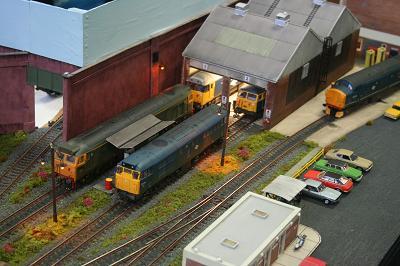 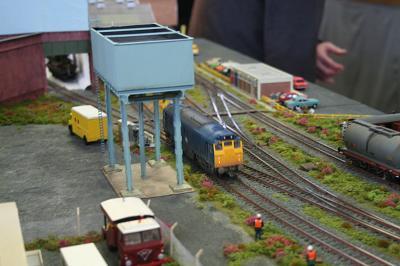 | |
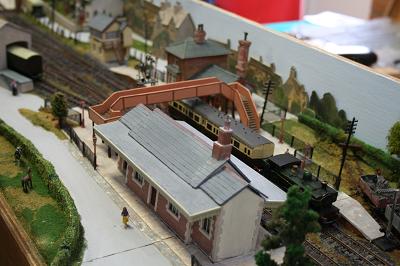 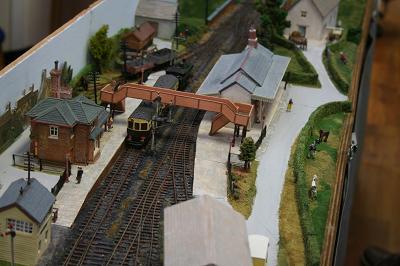 |
A fictitious layout based on the concept that the M&SWI continued as a secondary route though the Cotswolds despite the Great Western Railways endeavours to rationalise it during previous years. The era is set during the 1950's and allows through trains to be run from the Midlands (LMS), Southern as well as a variety of Western (GWR) and lately British Railways locomotives and rolling stock. The layout is 3.5 metres long and 500 mm wide with a fiddle yard at either end. It is built to a scale of 3mm to the foot | |
Bow Locks Bow Locks is a fictional layout set somewhere at the east end of the North London line near the Regents Canal; although Bow Locks is a real place name there is no railway there now. It represents the Network Southeast era of British Rail, with passenger services running to a single platform terminus and freight trains shunting in a simple three road yard. The high level passenger line features third rail electrification and a variety of units can be seen providing the train service. Bow Locks was built as a distraction from a much larger layout in my life. This model railway was designed to be easily portable, quick to put up and take down for the times that I want to be able to play trains without having the time to erect the larger layout. The trains are DCC operation, however points and signal are traditionally controlled from a switch box. | 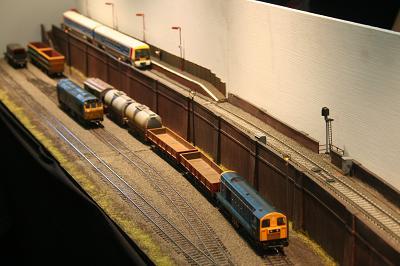 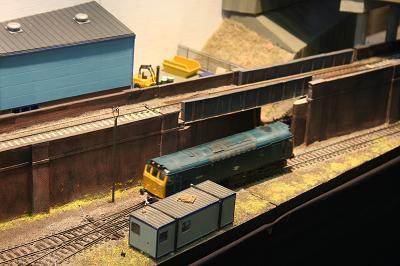 | |
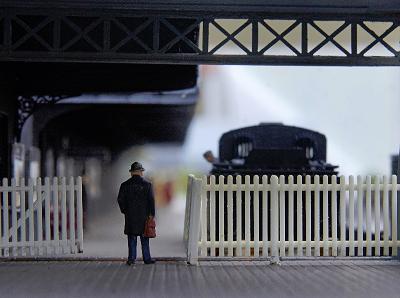 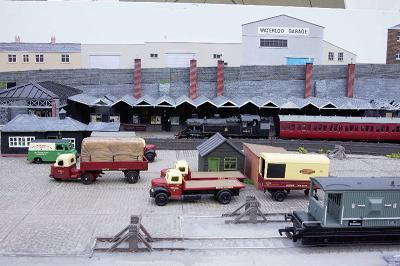 |
In 1870, the Midland Railway opened a small single platform passenger terminus in a corner of its extensive St Philips goods yard, in order to relieve pressure on the facilities it shared with the GWR at Temple Meads. For the next 80 years, Bristol (St Philips) was used almost exclusively for local passenger services via Mangotsfield to Bath (Queens Square), or Green Park as it later became. Passenger traffic survived until 1953, the station becoming, like many others, increasingly dilapidated after bomb damage during the war, while the goods yard remained open until 1967 � featuring in the excellent 1957 British Transport Films production �Fully Fitted Freight�, which is viewable on YouTube. The model is of the passenger station and the first few sidings of the goods yard. The scenic break is provided by Barrow Road bridge. long gone, which using modelers' license we have moved about half a mile closer to the station than it was in real life. The model works on the premise that passenger traffic was sufficient to maintain services until the goods yard closed in the early sixties. As in reality, the local passenger service is in the hands of a variety of tank engines, ex-LMS or BR standards, while goods traffic utilizes a wide range of large and small locos based on the nature of the train, but all appropriate to the period and local shed allocations. Early diesels also make an appearance. Control is entirely DCC. This includes not only the locos but also the points and the turntable. Our friendly operators will be delighted to explain (or complain about) the intricacies of DCC, but preferably not while they are trying to navigate the �macro� which controls the double slip at the entrance to the station area! | |
Forest Gate Parkway Forest Gate, is a fictional location, not to be confused with Forest Gate in London, but placed roughly around the Worcester and Gloucester area. The town has a mix of old and new buildings not all currently occupied. Despite this construction of a number of new buildings continues, structure are still being squeezed onto every inch of available land. The station and associated buildings were constructed on a disused railway yard which used to feed the factory. Constructed in the early eighties when traffic was relatively light, the car park is now too small and the station building is very inefficient, especially during rush hour. A number of train operating companies run services to and from the station, these including First Great Western and Arriva Trains Wales. It is not unusual to see many varied liveries especially where stock has been transferred from other regions. Although located firmly on the English side of the border, the Parkway station is, in my strange world, maintained by Arriva Trains Wales. The large factory at the southern end of the layout is based loosely on the Forgemasters Limited plant in Taffs Well, just north of Cardiff. It is still busy and regularly receives coiled sheet in various telescopic steel hood wagons, the freight cars are backed directly into the building or left on its solitary siding. The condition of the buildings on the site have deteriorated over the years with the original offices now empty and about to be demolished to make way for yet more modern structures. The scenic section of the layout is 11 feet by 2 feet with the whole layout measuring 13 by 6. It is mainly DCC sound and is as up to date as possible given how often train operating companies change their liveries. It has been a joy to build though there are still areas yet to be finished and I am currently working on a further 6 foot extension. | 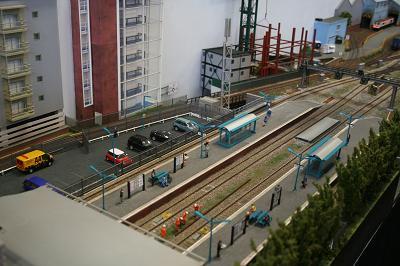 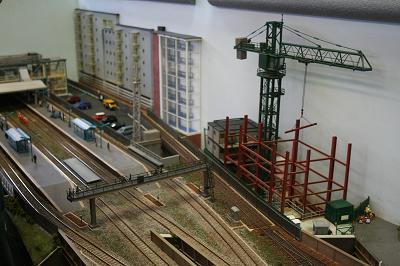 | |
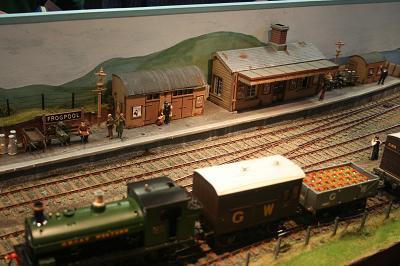 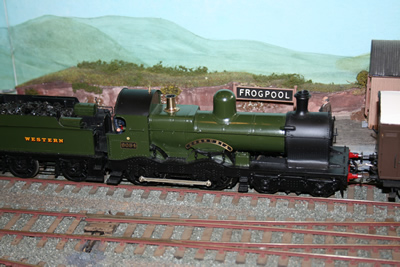 |
A highly fictitious and improbably small GWR terminus, somewhere between Falmouth and Truro. The village of Frogpool actually exists but in reality was never served by the railway. The layout was built by club member Tony Collins as an exercise in minimum space and is featured in the first Gauge O Guild book of small layouts published a few years ago. The buildings are based on the following prototypes: station on Adelstrop plans from GWR Country Stations by Chris Leigh; signal cabin on Burghclere from a photograph in Didcot, Newbury and Southampton Railway by Kevin Robertson and Roger Simmonds; large lamp room and store on Tetbury from plans; lamp hut on Lambourn from plans; goods shed on Hemyock from photographs; bridge on Fairford from photographs, all these in Great Western Branch Line Termini by Paul Korau. Other items based on no particular prototype. | |
Hounslow Sidings The town of Hounslow is in Middlesex, West London near to Heathrow Airport, it is on the British Rail Southern railway. The station is situated on the Twickenham and Brentford loop from Waterloo, my railway is British Railways based in the 1950 to 1960 period.
There is very little information, I could find, on the area or era modelled. Much of my model is produced from my memory, Hounslow is where I was brought up and also I do remember shunting there when I was a fireman at Feltham motive power depot. A Barracks at Hounslow Heath, meant the station was used as a military vehicle loading station during World War 2. The only photographs I can find are taken from a footbridge over the railway looking towards the station buildings. The viewing side of the layout was produced from what I can remember. It is viewed from the bottom of terraced house gardens, sorry if you know more about the yard. Operating system is by MERG DCC and the turnout is operated by MERG servo4 circuit board with a Tower Servo. Lighting is off LED stripe (soft white), all of the buildings are scratch built in the same architectural style as the Hounslow area. The footbridge I have brought forward to fit within a 4 foot length by 2 foot width. The fiddle yard is 18 inches length by 2 foot width, it has a sector plate type running on draw runners turned on their back, so overall size of the layout is 5 feet 6 inches by 2 feet. The locomotives consist of a class 08, PDK kit Q1 and a PDK kit M7, all locomotives that would have been at Feltham Motive Power Depot. | 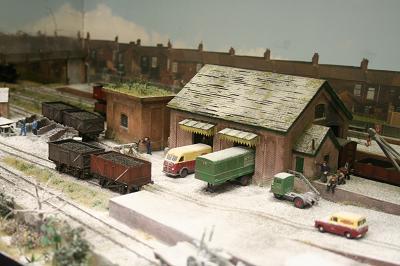 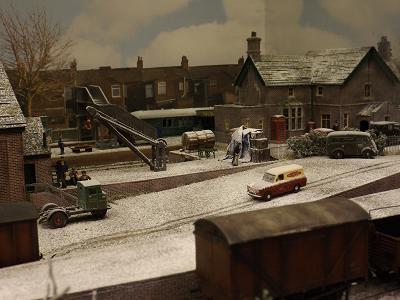 | |
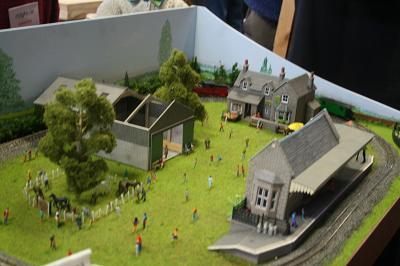 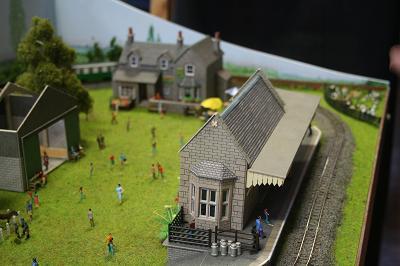 |
Island Farm was created as a layout for children to operate for a small donation to a nominated charity, usually Macmillan, but for this weekend we will collect for Sue Ryder. It is a 009 gauge layout based in a field somewhere in the world. There is a donkey sanctuary with children's play area, tea room, animals and plenty of visitors; enjoy. | |
Journey's End JOURNEYS END features a narrow gauge railway serving a cemetery. It is entirely fictional, set somewhere in England, though inspired by the London Necropolis Railway that ran from Waterloo to Brookwood, Surrey, from 1854 until 1941. The narrow gauge dimension was inspired by the Golden Valley Light Railway in Derbyshire, which runs from the Midland Railway Centre at Butterley towards a natural burial ground. The setting is almost timeless, but can be dated by use of different vehicles anytime from the present back to the 1950s. A particular, and probably unique, feature of the layout is its ghost train, comprising several ghost figures (made by Aidan Campbell) hauled by a diesel loco with a ghost headboard. There are also several Ffestiniog Railway hearse vans, in different liveries, and a model of the LSWR hearse van, as used on the London Necropolis Railway, is under construction for use on the layout. Other rolling stock, including steam and diesel locos, is mainly by Roco or Liliput, with some kit or scratch-built items, including a double ended railbus. The basic structure baseboard, track laying, wiring and controls was professionally constructed in 2011 by Model Masters of Weston-Super-Mare. It has two tracks, independently operated, one a continuous loop, and several working features by Viessmann, including level crossing lights, a gravedigger (if hes not too tired) and a man with a scythe (the Grim Reaper). A cemetery lodge and chapel are the main buildings on the layout, with several scratch-built mausoleum structures and platform waiting building also present. The gravestones and monuments are from a variety of sources, including Hornby, Harburn Hamlet, Dornaplas, Langley, Woodland Scenics, Busch, etc and the angel statues and other figures are mainly by Preiser and Noch. The mausoleums are mostly scratch-built, though two are adapted Hornby Skaledale structures. The vehicles are also from a variety of sources, the hearses and limousines being from Oxford Diecast, and there are some horse drawn hearses and carriages by Preiser. | 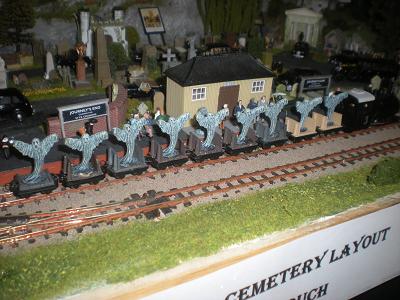  | |
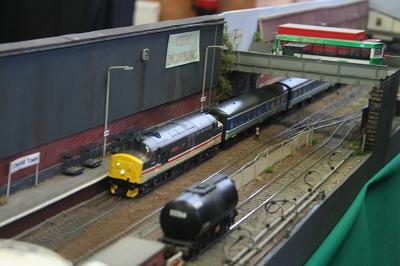 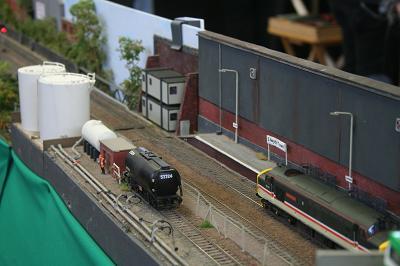 |
Llwydd is presumed to be a new town in north-east Wales at the end of a spur from the Shrewsbury to Chester line. It is now growing rapidly and this has led to a big revival in rail travel. The original Cambrian Railway station has been demolished and the yard has been cleared and sold. A new modern station, built to a heritage theme, has been funded by the supermarket which occupies most of the site. Royal Mail has concentrated its bulk operations here. These use a concrete loading pad on a short siding and, at quieter times, the one remaining platform. The only freight traffic serves a small oil terminal belonging to Cambrian Fuels. There are Diesel Multiply Unit (DMU) operated passenger services to and from Birmingham, Chester, Manchester, Shrewsbury and Wolverhampton. There is also a Regional Railways locomotive-hauled service to Cardiff and an Inter-City service to London. Royal Mail operates services to Cardiff, Preston and Crewe, as well as making use of some of the passenger workings. The Shrewsbury to London Euston TPO now also starts from Llwydd. This runs to Rugby where it combines with another service, the stock stables at Shrewsbury during the daytime. The oil terminal is supplied by an as-required service from Stanlow which can run on any day. DMUs are a mixture of First Generation and Sprinter units. Locomotives comprise classes 31, 37 and 47. Services represent those seen on the Marches lines in the late 1980s and early 1990s. The layout was built by George Woodcock. | |
Project Iraq 2003 1st May 2003 somewhere near to Basra in Southern Iraq and the main fighting in this area of the Invasion of Iraq is over. The model depicts a section of the British Army on Operation Telic taking stock of the situation before moving on to their next objectives. Telic from the Greek telos means a purposeful or defined action. With 46000 full time and reserve British troops being deployed the term became known amongst personnel as a backronym Tell Everyone Leave Is Cancelled. Amazingly they have come across the working remnant of a railway constructed by their forefathers about 80 years ago, the Maquil Railway. The local Iraqis are celebrating their freedom from the tyranny of Saddam Hussein's regime by returning to normal life as soon as possible and so the run down battered railway has returned quickly to its main role of moving water and agricultural produce. Project Iraq 2003 is a simple run round layout. Built to a scale of 1/35, it runs on a 16.5mm track gauge representing the original 600mm gauge.
It is very highly detailed with over 17 vehicle and 120 figures in cameo scenes. The more you look at it the more detail you will see. Project Iraq 2003 supports Help the Heroes. | 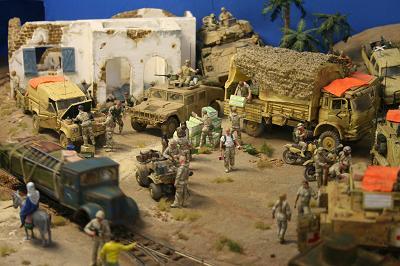 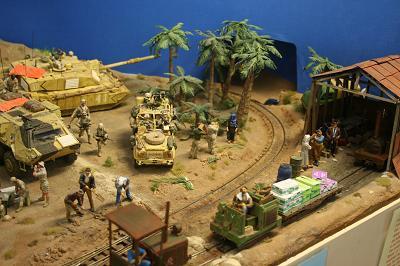 | |
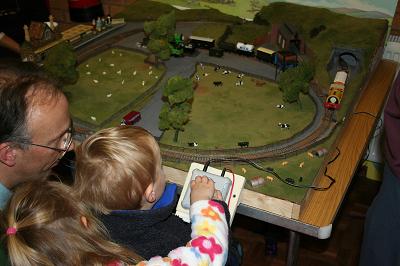 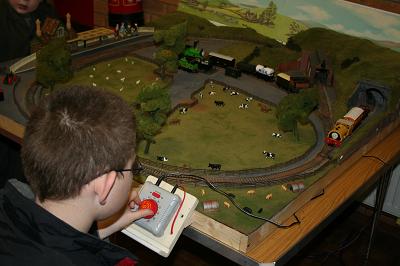 |
We would like to thank Trevor Hallam for looking after the Thomas Layout for many years at our exhibitions and also for refurbishing it at his expense. Unfortunately because of ill health Trevor is no longer able to continue so it was decided to offer Thomas free of charge to Hucclecote Railway Modellers on condition they bring it to all of our future exhibitions. This is the model railway where Children can become Engine Drivers on the Island of Sodor and has of course been inspired by the Reverend Audrey books. Our Thomas and Friends layout has been built for ten years now and in that time we hope it has encouraged many new railway enthusiasts to build a train set of their own. Originally it was intended as a space filler at shows so needed to be small, easy to transport and have a simple track plan, easy for small children to operate. After its first appearance it was clear this model railway would have to be included at all our exhibitions. It incorporates a tunnel, station, level crossing together with locomotive and goods facilities. Train drivers should look out for many of the popular characters; Henry, Percy, Toby, Cranky, the Troublesome Trucks, not forgetting the Sir Topham Hatt better known as the Fat Controller. The famous anthropomorphised rolling stock is mostly from the Thomas range and we are sure most of the adults and all the kids will love it. Happy Driving, but please observe the track speed limits. | |
| Displays | ||
Southdown buses | Model Bus Federation WEBSITE | |
NARTM (road transport) WEBSITE | Travel 2000 Ltd | |
Tony's Toys | Mini scenes | |
BRS Depot | Gloucester RC&W Museum | |
To tbe manor burnt | ||
| Modelling Demonstrations | ||
| Mark Begley | Richard Bucknall | |
| Steve Harrod | ||
| Trade | ||
| Cheltenham Model Centre WEBSITE | Derails Models WEBSITE | |
| Iron Horse DVDs | RCSW (Pre-owned) Models, Clive Reid | |
| Rly books, timetables, photos, Stewart Blencowe WEBSITE | ||